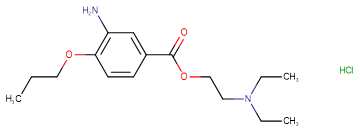
Proparacaine hydrochloride
CAS No. 5875-06-9
Proparacaine hydrochloride( Proxymetacaine hydrochloride )
Catalog No. M15166 CAS No. 5875-06-9
An irreversible local anesthetic; inhibits pain sensations that is believed to act as an antagonist on voltage-gated sodium channels.
Purity : >98% (HPLC)
 COA
COA
 Datasheet
Datasheet
 HNMR
HNMR
 HPLC
HPLC
 MSDS
MSDS
 Handing Instructions
Handing Instructions
| Size | Price / USD | Stock | Quantity |
| 50MG | 32 | In Stock |


|
| 100MG | 45 | In Stock |


|
| 200MG | 65 | In Stock |


|
| 500MG | Get Quote | In Stock |


|
| 1G | Get Quote | In Stock |


|
Biological Information
-
Product NameProparacaine hydrochloride
-
NoteResearch use only, not for human use.
-
Brief DescriptionAn irreversible local anesthetic; inhibits pain sensations that is believed to act as an antagonist on voltage-gated sodium channels.
-
DescriptionAn irreversible local anesthetic; inhibits pain sensations that is believed to act as an antagonist on voltage-gated sodium channels.Pain Approved(In Vitro):Proparacaine Hydrochloride (>588.93 μM; 4-28 hours) has a dose- and time-dependent cytotoxicity to HCS cells at concentrations in vitro.Proparacaine Hydrochloride (294.47-18.85 mM; 4-12 hours) can induce apoptosis of HCS cells .Proparacaine Hydrochloride (4.71 mM; 4-12 hours) induces G1 phase arrest, plasma membrane permeability elevation, phosphatidylserine externalization, DNA fragmentation, chromatin condensation, and apoptotic body formation of HCS cells.Proparacaine Hydrochloride induces caspase-2, -3 and -9 activation, and mitochondrial transmembrane potential disruption.Proparacaine Hydrochloride (4.71 mM; 4-12 hours) downregulates and upregulates the expression of Bcl-xL and Bax, respectively, and remarkably upregulates cytoplasmic cytochrome C and apoptosis inducing factor.(In Vivo):Proparacaine Hydrochloride (75 μg/30 μL; intranasal administration; for 7 days) significantly decreases nasal symptoms, number of eosinophils, goblet cells, and mast cells in the lamina propria of the nasal mucosa.
-
In VitroProparacaine Hydrochloride (>588.93 μM; 4-28 hours) has a dose- and time-dependent cytotoxicity to HCS cells at concentrations in vitro.Proparacaine Hydrochloride (294.47-18.85 mM; 4-12 hours) can induce apoptosis of HCS cells .Proparacaine Hydrochloride (4.71 mM; 4-12 hours) induces G1 phase arrest, plasma membrane permeability elevation, phosphatidylserine externalization, DNA fragmentation, chromatin condensation, and apoptotic body formation of HCS cells.Proparacaine Hydrochloride induces caspase-2, -3 and -9 activation, and mitochondrial transmembrane potential disruption.Proparacaine Hydrochloride (4.71 mM; 4-12 hours) downregulates and upregulates the expression of Bcl-xL and Bax, respectively, and remarkably upregulates cytoplasmic cytochrome C and apoptosis inducing factor. Cell Viability Assay Cell Line:HCS cells Concentration:294.47 μM, 588.93 μM, 1.18 mM, 2.35 mM, 4.71 mM, 9.42 mM, 18.85 mM Incubation Time:4 hours, 8 hours, and 12 hours, 16 hours, 20 hours, 24 hours, 28 hours Result:Decreased the viability of HCS cells with concentration and time at concentrations above 588.93 μM.Apoptosis Analysis Cell Line:HCS cells Concentration:294.47 μM, 588.93 μM, 1.18 mM, 2.35 mM, 4.71 mM, 9.42 mM, 18.85 mM Incubation Time:4 hours, 8 hours, and 12 hours Result:Induced apoptosis of HCS cells.Cell Cycle Analysis Cell Line:HCS cells Concentration:4.71 mM Incubation Time:4 hours, 8 hours, and 12 hours Result:Arrested HCS cells at the G1 phase of the cell cycle.Western Blot Analysis Cell Line:HCS cells Concentration:4.71 mM Incubation Time:4 hours, 8 hours, and 12 hours Result:Down-regulated the expression level of anti-apoptotic protein Bcl-xL and up-regulated the pro-apoptotic protein Bax, whereas significantly up-regulated the cytoplasmic amounts of mitochondria-released cytochrome C and apoptosis-inducing factor (AIF).
-
In VivoProparacaine Hydrochloride (75 μg/30 μL; intranasal administration; for 7 days) significantly decreases nasal symptoms, number of eosinophils, goblet cells, and mast cells in the lamina propria of the nasal mucosa. Animal Model:7-week-old female BALB/c mice, allergic rhinitis model Dosage:75 μg/30 μL Administration:Intranasal administration, for 7 days Result:Significantly reduced nasal rubbing and sneezing.
-
SynonymsProxymetacaine hydrochloride
-
PathwayMembrane Transporter/Ion Channel
-
TargetSodium Channel
-
RecptorVoltage-gatedsodiumchannel
-
Research AreaNeurological Disease
-
IndicationPain
Chemical Information
-
CAS Number5875-06-9
-
Formula Weight330.8502
-
Molecular FormulaC16H27ClN2O3
-
Purity>98% (HPLC)
-
Solubility10 mM in DMSO
-
SMILESCCCOC1=C(C=C(C=C1)C(=O)OCCN(CC)CC)N.Cl
-
Chemical NameBenzoic acid, 3-amino-4-propoxy-, 2-(diethylamino)ethyl ester, hydrochloride (1:1)
Shipping & Storage Information
-
Storage(-20℃)
-
ShippingWith Ice Pack
-
Stability≥ 2 years
Reference
1. Gusovsky F, et al. Brain Res. 1990 Jun 4;518(1-2):101-6.
2. McAlvin JB, et al. Invest Ophthalmol Vis Sci. 2015 Jun;56(6):3820-6.
3. Hung CH, et al. Anesth Analg. 2010 Jan 1;110(1):238-42.
molnova catalog



related products
-
Bulleyaconi cine A
Bulleyaconitine A is an analgesic and antiinflammatory drug isolated from Aconitum plants; has several potential targets, including voltage-gated Na+ channels.
-
Nav1.8-IN-4
Nav1.8-IN-4 is a potent Nav1.8 channel inhibitor with potential analgesic activity.Nav1.8-IN-4 can be used for pain and neurological related disorders.
-
E 0747
E 0747 (E0747) is a new antiarrhythmic compound that inhibits arrhythmias by inhibiting Na channels in cardiac cells.



 Cart
Cart
 sales@molnova.com
sales@molnova.com


